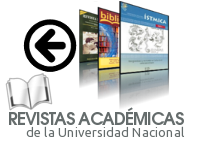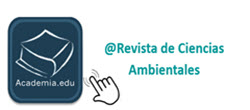Can mycetozoans be used as health indicators of soil in the agricultural context of Costa Rica?
DOI:
https://doi.org/10.15359/rca.52-1.9Keywords:
biosystems, dictyostelids, myxomycetes, myxogastrids, sugar caneAbstract
The study of the populations of micetozoos in agroecosistemas with diverse characteristics and degrees of disturbance by anthropogenic activities is a subject with scarce investigation at world-wide level. In order to study this interaction, we documented the incidence of two groups of micetozoos (mixogastrids and dictyostelids) in two agricultural systems of sugar cane and pineapple in Costa Rica. For each study system we quantify a series of edaphic, chemical and landscape variables. After the analysis, we found that, for both groups, three variables explained 99% of the variability of incidence of these. For the dictyostelids, the variables were percentage of clay, pH and microbial biomass. In the case of mixogastrids, these variables were Manganese, microbial respiration and pH. The previous results indicate a potential medium for the use of micetozoos as environmental indicators, while the effect of the culture systems on the activity of the microorganisms was quantifiable. However, we believe that it is still necessary to define the role of the different variables measured on the dynamics of both groups of microorganisms in order to establish a conclusion with potential application, supported by empirical data.References
Bunning, S., & Jimenez, J. (2003). Indicators and Assessment of Soil Biodiversity/Soil Ecosystem Functioning for Farmers and Governments. In OECD Expert Meeting on indicators of Soil Erosion and Soil Biodiversity. Rome.
Cardoso, E. J. B. N., Vasconcellos, R. L. F., Bini, D., Miyauchi, M. Y. H., Santos, C. A. dos, Alves, P. R. L., … Nogueira, M. A. (2013). Soil health: looking for suitable indicators. What should be considered to assess the effects of use and management on soil health? Scientia Agricola, 70(4), 274-289. doi: 10.1590/S0103-90162013000400009
Cavalier-Smith, T., Fiore-Donno, A. M., Chao, E., Kudryavtsev, A., Berney, C., Snell, E. A., & Lewis, R. (2015). Multigene phylogeny resolves deep branching of Amoebozoa. Molecular Phylogenetics and Evolution, 83, 293-304. doi: 10.1016/j.ympev.2014.08.011
Clark, J., & Ef, H. (2015). Myxomycete plasmodial biology: a review, 6(October), 643-657. doi: 10.5943/mycosphere/6/6/1
Crowley, D. E., y Alvey, S. A. (2002). Regulation of microbial processes by soil pH. In: Z. Rengel, (Ed.). Handbook of Plant Growth: pH as the Master Variable. EE. UU.: Marcel Dekker.
Díaz-Romeu, R. y Hunter, A. (1982). Metodología de muestreo de suelos, análisis químico de suelos y tejido vegetal y de investigaciones en invernadero. Turrialba: CATIE.
Dubey, R. K., Tripathi, V., & Abhilash, P. C. (2015). Book Review: Principles of Plant-Microbe Interactions: Microbes for Sustainable Agriculture. Frontiers in Plant Science, 6(November), 1-448. doi: 10.3389/fpls.2015.00986
Eldor, P. (2015). Soil Microbiology, Ecology, and Biochemistry. In Soil Microbiology, Ecology and Biochemistry (pp. 1-14). Elsevier. doi: 10.1016/B978-0-12-415955-6.00001-3
Esteban, G. F., Finlay, B. J., & Warren, A. (2014). Free-Living Protozoa. Thorp and Covich’s Freshwater Invertebrates: Ecology and General Biology: Fourth Edition, 1, 113-132. doi: 10.1016/B978-0-12-385026-3.00007-3
Feest, A., & Stephenson, S. (2014). The response of myxogastrids to soil amendments, 5 (November), 821-829. doi: 10.5943/mycosphere/5/6/12
Fiore-Donno, A. M., Nikolaev, S. I., Nelson, M., Pawlowski, J., Cavalier-Smith, T., & Baldauf, S. L. (2010). Deep Phylogeny and Evolution of Slime Moulds (Mycetozoa). Protist, 161(1), 55-70. doi: 10.1016/j.protis.2009.05.002
Hastie, T., Tibshirani, R., & Friedman, J. (2009). The Elements of Statistical Learning: Data Mining, Inference, and Prediction. Elements, 1, 337-387. doi: 10.1007/b94608
Henríquez, C., Bertsch, F., & Salas, R. (1995). Fertilidad de suelos: manual de laboratorio. San José: Asociación Costarricense de la Ciencia del Suelo.
Hoppe, T., & Schnittler, M. (2015). Characterization of myxomycetes in two different soils by TRFLP- analysis of partial 18S rRNA gene sequences, 6(April), 216-227. doi: 10.5943/mycosphere/6/2/11
Jenkinson, D. S., & Powlson, D. S. (1976). The effects of biocidal treatments on metabolism in soil—V. Soil Biology and Biochemistry, 8(3), 209-213. doi: 10.1016/0038-0717(76)90005-5
Kaleita, A. L., Schott, L. R., Hargreaves, S. K., & Hofmockel, K. S. (2017). Differences in soil biological activity by terrain types at the sub-field scale in central Iowa US. PLoS ONE, 12(7), 1-13. doi: 10.1371/journal.pone.0180596
Keller, H. W., & Everhart, S. E. (2010). Importance of Myxomycetes in Biological Research and Teaching. Papers in Plant Pathology of the University of Nebraska-Lincoln, 3(1), 13-27. Recuperado de http://ever77.myweb.uga.edu/Publications/Everhart_2010_ImportanceofMyxomycetes.pdf
Kryvomaz, T., & Stephenson, S. (2017). Preliminary evalution of the possible impact of climate change on myxomycetes. Papers in Plant Pathology of the University of Nebraska-Lincoln, 104(1), 5-30. doi: 10.1127/nova_hedwigia/2016/0379
Mueller, U. G., & Sachs, J. L. (2015). Engineering Microbiomes to Improve Plant and Animal Health. Trends in Microbiology, 23(10), 606-617. doi: 10.1016/j.tim.2015.07.009
Pimentel, M. (2007). Manipulating Ecosystems for Agriculture. In Food, Energy, and Society, Third Edition (pp. 37-44). CRC Press. doi: 10.1201/9781420046687.ch5
Rojas, C., & Kryvomaz, T. (2017). Myxomycetes in the 21st Century. In C. Rojas & S. Stephenson (Eds.), Myxomycetes: Biology, Systematics, Biogeography and Ecology. Academic Press.
Romeralo, M., Escalante, R., & Baldauf, S. L. (2012). Evolution and Diversity of Dictyostelid Social Amoebae. Protist, 163(3), 327-343. doi: 10.1016/j.protis.2011.09.004
Spiegel, F., Haskins, E. F., Cavender, J. C., Landolt, J. C., Lindley-settlemyre, L. A., Edwards, S. M., … Shadwick, J. D. (2005). A beginner’s guide to isolating and culturing eumycetozoans. Retrieved from papers://560067a4-156f-4d6d-b6cc-2f64c208798b/Paper/p167
Stephenson, S. L., Fiore-Donno, A. M., & Schnittler, M. (2011). Myxomycetes in soil. Soil Biology and Biochemistry, 43(11), 2237-2242. doi: 10.1016/j.soilbio.2011.07.007
Swanson, A. R., Vadell, E. M., & Cavender, J. C. (1999). Global distribution of forest soil dictyostelids. Journal of Biogeography, 26(1), 133-148. doi: 10.1046/j.1365-2699.1999.00250.x
Tibshirani, R. (1996). Regression Shrinkage and Selection via the Lasso. Journal of the Royal Statistical Society B, 58(1), 267-288. Recuperado de https://statweb.stanford.edu/~tibs/lasso/lasso.pdf
Vance, E. D., Brookes, P. C., & Jenkiinson, D. S. (1987). An Extraction Method for Measuring Soil Microbial Biomass C. Soil Biology and Biochemistry, 19(6), 703-707. doi: 10.1016/0038-0717(87)90052-6
Wang, X., Liu, L., Piao, S., Janssens, I. A., Tang, J., Liu, W., … Xu, S. (2014). Soil respiration under climate warming: differential response of heterotrophic and autotrophic respiration. Global Change Biology, 20(10), 3229-3237. doi: 10.1111/gcb.12620
Whiting, D., Wilson, C., & Card, A. (2002). Estimating Soil Texture Sandy, Loamy, or Clayey? Colorado Master Gardener. Program Colorado Gardener Certificate Training CMG Fact Sheet #S14, (December 2003), 1-7.
Zhou, L., Zhou, X., Zhang, B., Lu, M., Luo, Y., Liu, L., & Li, B. (2014). Different responses of soil respiration and its components to nitrogen addition among biomes: a meta-analysis. Global Change Biology, 20(7), 2332-2343. doi: 10.1111/gcb.12490
Downloads
Published
How to Cite
Issue
Section
License

This work is licensed under a Creative Commons Attribution-NonCommercial-ShareAlike 4.0 International License.


















